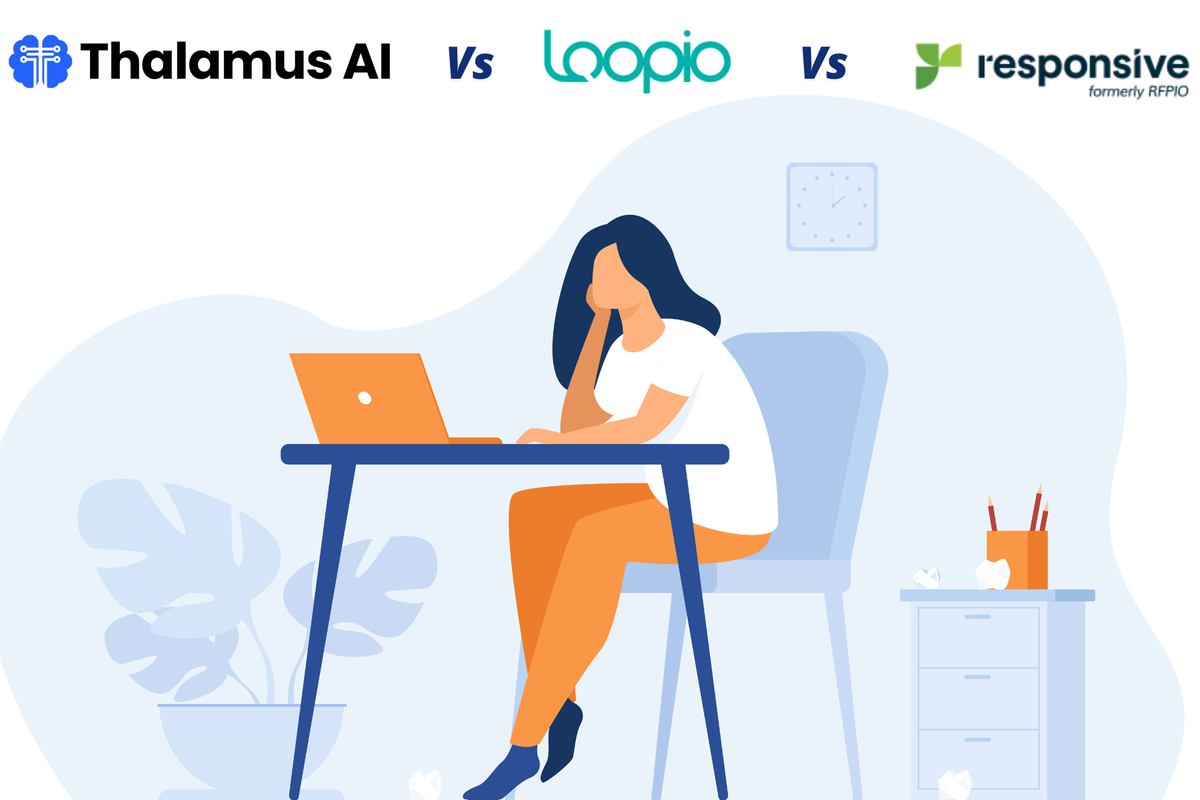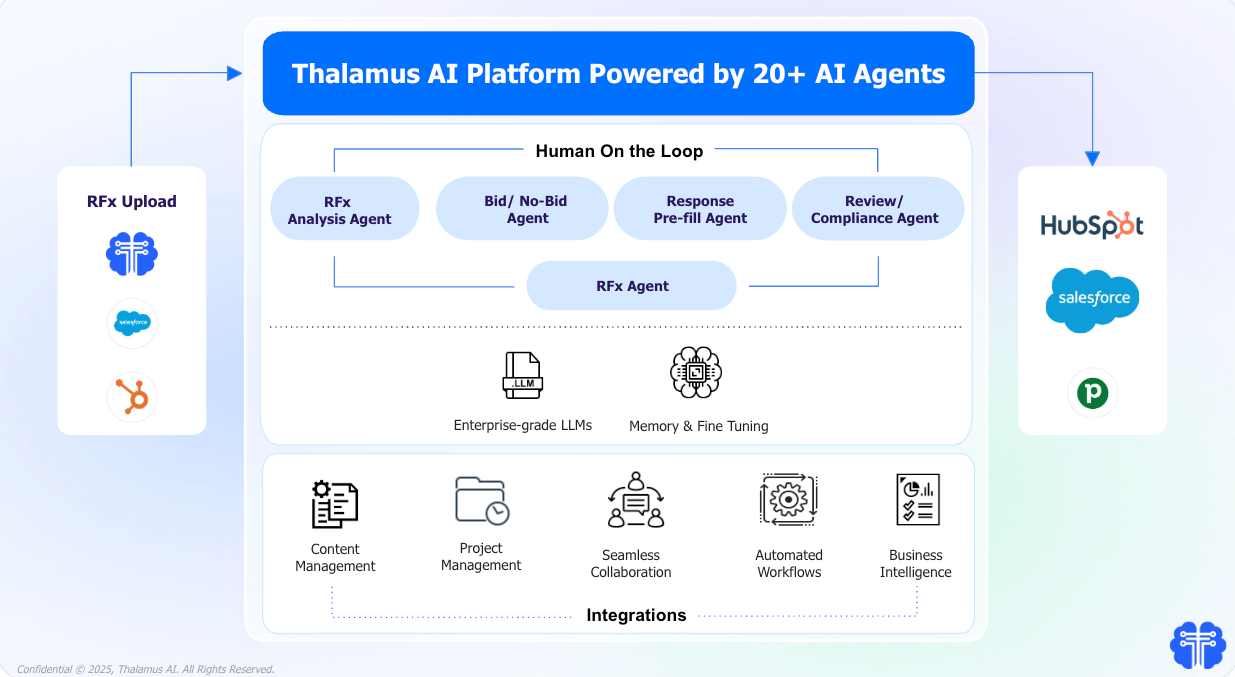Best RFP Software for Enterprises in 2025: Compare Loopio, Responsive And Thalamus AI

Winning new business in today’s competitive markets means responding to RFPs, RFQs, Security Questionnaires, and Due Diligence forms faster and smarter, than ever before. Yet for most enterprise sales, security, and proposal teams, the RFP response process remains a major bottleneck: too manual, too fragmented, and too slow to meet ambitious growth targets.
In fact, 58% of proposal teams say they waste significant time just searching for relevant content. Meanwhile, over 65% of enterprises now rely on RFP software to reduce response cycle times by up to 40% (Source: Loopio 2024 RFP Trends). And the payoff? Organizations with advanced RFP automation software report:
- Up to 11% higher win rates
- 7% faster sales cycles
That’s where modern RFP response platforms come in - purpose-built to simplify proposal workflows, enhance collaboration, and improve accuracy. These platforms blend content management, AI-powered automation, and built-in compliance tools to help organizations deliver higher-quality proposals in less time.
Ready to elevate your RFP game? Schedule a discovery call. Or Read more about it at RFP & Proposal Suite
In this guide: We compare three top-rated RFP management software platforms for enterprises in 2025:
- Loopio: The go-to for structured content libraries and team collaboration.
- Responsive (formerly RFPIO): Renowned for compliance-heavy workflows and advanced analytics.
- Thalamus AI: The only AI-powered RFP response software that delivers 95% accurate first drafts in under 5 minutes, tailored to any RFP, RFQ, or Questionnaire.
Whether you're trying to optimize your proposal process or scale high-volume bid responses, this guide will help you choose the best platform for your business needs.
What is RFP Software?
RFP software, also known as RFP response management software, is a specialized platform designed to streamline the proposal process, from the moment an RFP, or RFQ, arrives to the final submission.
It helps proposal teams, sales teams, and subject matter experts (SMEs) collaborate efficiently by providing a centralized content library, automated workflows, and advanced collaboration tools.
Instead of wasting time hunting previous answers across documents, shared drives, or emails, teams can auto-fill proposals, manage compliance, and track progress in one cloud-based software platform.

Image: Thalamus AI RFP Platform: Powered by 20+ AI Agents automating every stage of your RFP workflows - automating content management, collaboration, compliance, and business intelligence. Read more at thalamushq.ai.
As highlighted in image above, Modern AI-powered RFP software platforms, like Thalamus AI, go even further by using generative AI and AI agents to analyze RFP documents, pre-fill responses with 95% accuracy, and route tasks to the right experts, all while ensuring compliance with security standards like SOC 2 and ISO 27001 (Source: Thalamus AI)
In short, RFP automation software helps enterprises:
- Accelerate response times
- Improve win rates
- Reduce risks in security and compliance questionnaires
- Standardize content management across teams
Whether it’s handling a 300-question questionnaire, a formal Request for Information (RFI), or a complex proposal draft, the right RFP software transforms how companies win business at scale.
A Closer Look: Loopio, Responsive, and Thalamus AI
Choosing the best RFP software can define how fast and how often your business wins. Let’s compare three of the most sought-after platforms in 2025: Loopio, Responsive Io, and Thalamus AI - each built for enterprises, but fundamentally different in approach and technology.
Loopio: Great for Static Content Libraries, But Limited Beyond That
Loopio remains a familiar name in the proposal management systems category. It's popular for Form based, Q&A RFPs, centralizing content, especially useful for teams that have well-maintained, structured content libraries.
Key Features:
- Content Libraries: Centralized, searchable libraries for pre-approved content.
- Workflow Automation: Rule-based automation for proposal progress tracking.
- Collaboration: Basic collaboration tools, yet requiring users to switch between multiple software screens.
- Security: Compliant with standard security protocols and role-based access.
However, Loopio operates on rule-based AI that matches questions to pre-tagged answers. It works well if your content is neat, but:
- It breaks when questions are phrased differently.
- It misses tone, nuance, and deeper context.
- There’s no learning from previous wins or SME inputs.
If you’re managing static, repetitive responses - Loopio helps. But for scaling complex responses or high-volume government contracting, the platform’s limitations can slow you down.
Responsive.io: Optimized for Compliance, But Still Template-Driven
Responsive.io (formerly RFPIO) positions itself as a strategic response management platform, especially suited for compliance-heavy organizations.
Key Features:
- Custom Workflows: Automate reviews, approvals, and response tracking.
- Security Questionnaires: Specialized support for Risk & Compliance teams.
- Analytics & Reporting: Track response intelligence, engagement, and proposal effectiveness.
- Integrations: Native integrations with Google Drive, O365, and CRM systems.
But Responsive.io too is built on rule-based AI, which:
- Relies on pre-tagged Q&A pairs, limiting adaptability.
- Lacks dynamic AI-powered proposal writing.
- Doesn’t support zero data retention or learning from each SME interaction.
Responsive is a solid fit for highly regulated industries but may feel rigid for teams needing fluid AI responses and content suggestions in real-time.
Thalamus AI: Built Different - Powered by 20+ Specialized AI Agents
Thalamus AI is redefining the space with a true AI-Powered Response Management platform. Unlike Loopio and Responsive, which use static libraries and templates, Thalamus AI leverages Agentic AI - a network of 20+ specialized AI agents, each trained for specific tasks.
Whether it’s automated workflows, project management, or zero copy-paste RFP responses, Thalamus AI eliminates inefficiencies that legacy platforms can’t.
What Makes Thalamus AI Stand Out:
- AI Agents Support at Every Step: From prefill, review, content tagging, compliance checks, to final submission, each task is powered by dedicated AI agents.
- Learns Continuously: Grows smarter with every proposal, incorporating feedback from SMEs, customer feedback, and submission outcomes.
- Zero Hallucination, Zero Copy-Paste: Answers are sourced from verified knowledge repositories, reducing risk in security questionnaires and regulated industries.
- Automated Knowledge Management: A living, AI-powered content services platform that adapts to evolving proposal needs.
- Seamless Integrations: Enterprise Ready Integration with Google Drive, O365, CRM tools, embedding AI directly into your sales tech stack.
- Response Intelligence: Get predictive insights, risk assessments, and recommendations powered by AI responses tailored to specific industries, RFP response elements, and geographical locations.
💡 Fact: With Thalamus, teams generate a 95% accurate draft in under 5 minutes, drastically cutting down manual effort while improving win rates by up to 2x within a month. Read more about Thalamus AI - Here.
In Summary:
If your proposal process depends on static content, Loopio suffices.
If compliance is king, Responsive.io is dependable.
But if you want an AI-powered RFP response platform that writes, learns, and adapts with every deal, Thalamus AI is your strategic advantage.
Each Agent brings sharp, focused intelligence to a stage. But together? They form a collective memory, learning from every submission, every SME interaction, every win/loss.
Ready to experience the next-gen of RFP software? Schedule a Demo with Thalamus AI today.
If you’re seeking the best RFP management software for 2025 to revolutionize your proposal process, Schedule a demo with Thalamus AI today and experience the future of RFP management.
- Read our Top 3 AI Proposal Software in 2026 comparison to see which platform leads in automation, multilingual proposals, and win-rate performance.
- Want to know what’s next in proposal management? Read the 12 RFP Trends Shaping Proposal Management in 2026.
- Check out Thalamus AI guide on comparison of Top 10 RFP Tools
- Looking for more detailed comparison, Read it here.
- Learn more about AI Agents in RFP Automation: AI Agents for RFP Automation: What They Are & Why Enterprises Are Finally Paying Attention
- For a deep dive into Agentic AI for Proposal/ Response Management, check out our post: How Agentic AI Platforms are Shaping the future of Proposal Management
- Additional Read: To Bid or Not to Bid? A Strategic Guide to Confident RFP Go/ No-Go Decisions
Frequently Asked Questions (FAQs) About RFP Software
1. What is an RFP Software?
An RFP solution, or Request for Proposal Software, is a specialized platform designed to streamline and enhance the response management process. It helps proposal teams respond to RFPs, RFQs, Questionnaires, and Due Diligence requests by automating workflows, improving collaboration, and ensuring compliance throughout the response lifecycle.
2. How do I find RFPs to respond to?
You can discover RFPs through platforms like GovWin IQ, ThomasNet, and other RFP aggregators. Setting up alerts and engaging in B2B networks can help uncover relevant opportunities early.
3. How does AI enhance RFP response software?
AI enhances RFP software by drafting winnable drafts - automating content discovery, and response generation. Solutions like Thalamus AI use specialized AI agents and generative AI to pre-fill proposals with up to 95% accuracy, suggest content based on prior submissions, and optimize compliance reviews, making the proposal process faster, smarter, and more data-driven.
4. How can RFP software help manage large volumes of RFPs?
RFP software automates repetitive tasks, standardizes content management, and facilitates real-time collaboration across teams. This makes it easier to scale operations, handle multiple complex RFPs simultaneously, and maintain high accuracy and compliance standards — even across global teams.
5. What should I consider for successful onboarding of RFP software?
For a smooth onboarding, establish clear internal workflows, train proposal managers and SMEs on using the platform, and ensure integration with existing tools like Google Drive, Microsoft 365, and CRM systems. Partnering closely with the software vendor’s support and onboarding team also accelerates adoption and success.
6. How long does it take to implement RFP response software?
Implementation times vary based on the platform’s complexity and the size of your organization. Traditional tools may take weeks or months, but modern solutions like Thalamus AI are designed to be up and running in under 48 hours, complete with native integrations and automated workflows.
7. Can RFP software be accessed remotely by distributed teams?
Yes. Most leading RFP platforms, including Thalamus AI, are cloud-based, enabling remote access for distributed teams. This facilitates collaboration between proposal managers, SMEs, sales, and compliance teams regardless of location, especially critical in today’s hybrid work environments.
8. Does RFP software support multiple languages and currencies?
Absolutely. Many advanced platforms such as Thalamus AI offer support for multiple languages and currencies, ensuring enterprises operating in global markets can localize proposals, manage regional compliance requirements, and streamline international sales processes.
9. What features should I look for in RFP automation software?
Key features to prioritize include:
- AI-powered content libraries that are not Q&A Based
- Automated workflows
- Real-time collaboration tools
- Comprehensive reporting and analytics
- Zero data retention policies for security
- Native integrations with cloud storage and CRM systems
These capabilities ensure faster, more accurate, and more secure proposal management.
10. What is Thalamus AI?
Thalamus AI is an Agentic AI Proposal & RFP Software built for enterprises to streamline response management across RFPs, security questionnaires, vendor forms, and complex proposals.
Powered by 20+ smart AI agents, Thalamus shreds Requests for Proposal (RFPs), tags requirements, and generates winnable first drafts in under 5 minutes, helping proposal teams respond 5x faster and win 2x more. By leveraging boilerplate content, past proposals, project data, and case studies, it delivers 95% accurate, client-tailored responses that reflect your organization’s unique voice and expertise.
Thalamus integrates seamlessly with SharePoint, OneDrive, Google Drive, Slack, Outlook, and Microsoft Teams. It centralizes enterprise knowledge into a centralized content library, enabling smooth collaboration across teams and subject matter experts.
Thalamus supports every type of RFx - from Q&A forms and security questionnaires to 100-page narrative proposals, enabling teams to deliver faster, more accurate, and higher-quality responses without sacrificing win rates.
Built with SOC 2, ISO 27001, and GDPR compliance, Thalamus provides secure, scalable RFP response management workflows. Trusted by 50+ enterprises worldwide including EBC Inc, Schnitzer Industries, and Whatfix, Thalamus is the Proposal & RFP platform for teams who want results, not just responses
